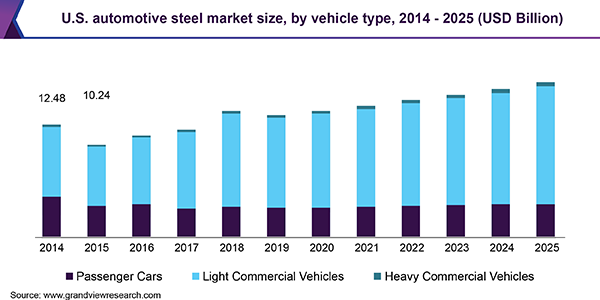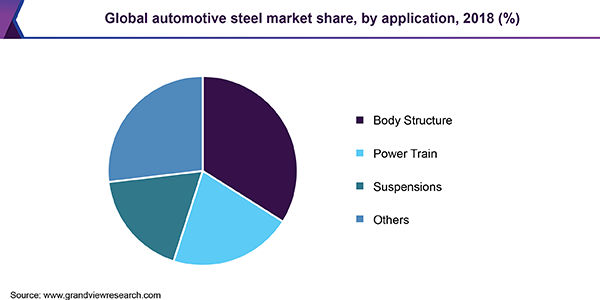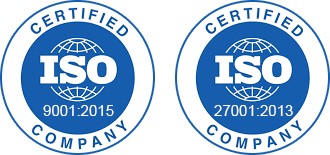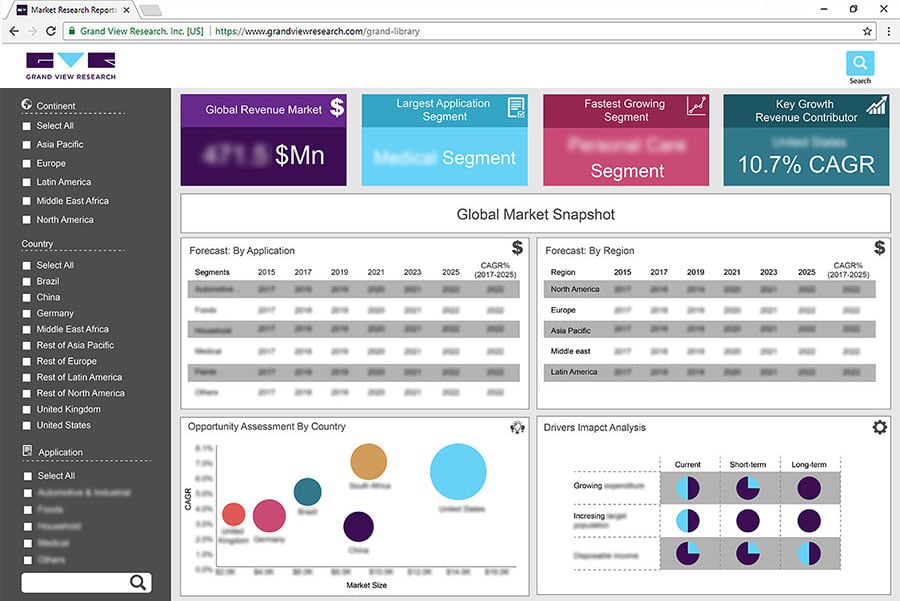- Home
- »
- Advanced Interior Materials
- »
-
Automotive Steel Market Size, Share, Global Industry Report 2019-2025GVR Report cover
![Automotive Steel Market Size, Share & Trends Report]()
Automotive Steel Market Size, Share & Trends Analysis Report By Application (Body Structure, Power Train, Suspension), By Vehicle Type (LCVs, HCVs), By Region, And Segment Forecasts, 2019 - 2025
- Report ID: GVR-2-68038-722-3
- Number of Report Pages: 109
- Format: PDF, Horizon Databook
- Historical Range: 2014 - 2017
- Forecast Period: 2019 - 2025
- Industry: Advanced Materials
Industry Insights
The global automotive steel market was valued at USD 104.47 billion in 2018 and is expected to witness a CAGR of 3.2% from 2019 to 2025. Increasing demand to reduce the weight of automobiles is expected to positively contribute in the industry growth.
The automotive industry faces numerous challenges including carbon dioxide (CO2) emissions. Weight reduction in different vehicles can help to achieve improved fuel efficiency, creating less impact on the environment. Materials such as metal composites and hot forming steel have immense potential to cut the weights in vehicles. It has been observed that hot forming steel has the ability to reduce vehicle weight by nearly 20% to 30%.

The U.S. is the largest producer as well as consumer of motor vehicles in North America. Automobile industry in the economy has been witnessing development in terms of types of vehicles being produced. While passenger cars and pickup trucks were the most commonly used vehicles, the introduction of high-quality compact sport utility vehicles (SUVs) has positively influenced the automotive sales in the U.S. It is expected that SUVs are likely to account for nearly 50% of the automotive sales by 2020.
Strict emission regulations and investment in green infrastructure are likely to contribute to the demand for various steel products in the automotive sector. For instance, The Government of Canada invested about USD 3.5 million in clean technologies and green infrastructure by increasing the number of zero-emission vehicles.
The government of Canada has also been partnering with the private sector to support the deployment of new charging stations for electric vehicles. In Canada’s 2019 budget, around USD 98 million are being allocated for charging infrastructure. The government is also offering incentives who are buying or leasing zero-emission vehicles.
Improvement and advancement in advanced high strength steels (AHSS) are anticipated to remain a key focus area for market vendors. AHSS materials have a unique combination of mechanical properties and help to achieve efficiency, safety, emissions, and durability at an economic cost. Safety regulations such as standards set by the National Highway Traffic Safety Administration (NHTSA) are likely to drive the use of these materials over the coming years.
Vehicle Type Insights
The passenger vehicles segment accounted for the highest automotive steel market share of 71.7% in 2018 in terms of revenue. A positive trend in sales of passenger cars In Asia Pacific region is anticipated to contribute to the growth of the industry. As per the OICA statistics, in 2018, countries including India, Thailand, Indonesia, and Malaysia observed overall automotive production growth of 2.6%, 7.2%, 7.5%, and 13.7% respectively.
Technological advancements coupled with an inclination of consumers toward autonomous vehicles are expected to remain key growth factors for passenger vehicles segment over the forecast period. Various leading companies around the world are currently working on different autonomous vehicle projects. For instance, in 2016, Amazon filed a patent for autonomous lane switching technology. In 2018, the company has also collaborated with Toyota for further development of autonomous vehicles.
Light commercial vehicles are anticipated to grow at CAGR of 4.4% in terms of volume. Demand for industrial and commercial transportation services is likely to impact sales of LCVs. In addition, rapid urbanization, improved road infrastructure, and supportive regulatory policies are likely to fuel the demand for LCVs over the coming years.
Application Insights
Body structure application accounted for a volume share of 35.6% in 2018. Body structure includes frame, panels, doors, bonnet, and trunk closures of the vehicles. This part of the automotive is generally manufactured from steel in order to provide robustness and crash energy absorption to the structure. Stringent regulations for safety around the various parts of the world is projected to drive the growth of the segment.
Rapidly growing focus on reduction of power train weight is likely to catalyze the utilization of lightweight materials in its components, particularly fuel-handling components. However, the market for automotive steel in this application is expected to witness moderate growth as compared to other segments on account of the increasing use of components made from plastics & composites.

In terms of revenue, suspension segment is anticipated to grow at CAGR of 3.1% from 2019 to 2025. The requirement of high rigidity and high strength in products is likely to augment the demand for automotive steel in suspension applications in the coming years. Suspension of a vehicle is prone to a high level of vibrations and stress. Hence, the material used in its components, particularly spring, should be able to withstand such stress without getting damaged.
Regional Insights
In terms of volume, North America is projected to grow at a CAGR of 2.8% during the forecast period. Expansion of the electric vehicles industry in the U.S., Canada, and Mexico are likely to benefit the industry growth. For instance, in April 2018, Zacua opened a new electric vehicle production plant in Puebla, Mexico, worth USD 4.3 million.
The German automotive industry is an integral and substantial part of the European automotive industry. Germany is a major country for industries including precision equipment, passenger cars, and heavy automotive vehicles. Rising exports of premium cars in Germany coupled with increasing R&D budgets for the development of premium cars is expected to propel the automotive steel market in the country.
In terms of revenue, Asia Pacific held 45.2% of market share in 2018. Consumer preference and favorable government policies are the key factors leading to the growth of the automotive industry in the Asia Pacific. Manufacturers are also coming up with new designs and manufacturing processes in order to meet the rapidly changing demand from the original equipment manufacturers (OEMs).
Automotive steel market share insights
Expansion and continuous production in developed countries such as the U.S. and Japan is likely to remain a key focus area for market participants. For instance., Japan houses some of the most globally renowned, large-scale auto brands. The country is home to key global automakers such as Toyota, Mitsubishi, Honda, Subaru, Nissan, Fuso, Daihatsu, Hino, Lexus, and Mazda among others. The demand from these automakers is projected to assist the market growth over the coming years.
ArcelorMittal, Tata Steel, JSW Group, Hyundai Steel, POSCO, U.S. Steel., JFE Steel Corp., China Steel Corp., and Nucor Corporation are some of the prominent manufacturers in the industry.
Report Scope
Attribute
Details
Base year for estimation
2018
Actual estimates/Historic data
2014 - 2017
Forecast period
2019 - 2025
Market representation
Volume in Kilotons, Revenue in USD Million & CAGR from 2019 to 2025
Regional scope
North America, Europe, Asia Pacific, Central & South America, Middle East & Africa
Country scope
U.S., Canada, Mexico, Germany, UK, France, China, India, Japan, Brazil
Report coverage
Revenue forecast, company share, competitive landscape, growth factors, and trends
15% free customization scope (equivalent to 5 analyst working days)
If you need specific market information, which is not currently within the scope of the report, we will provide it to you as a part of customization
Segments Covered in the ReportThis report forecasts revenue growth at the global and regional levels and provides an analysis of the industry trends in each of the submarkets from 2014 to 2025. For the purpose of this study, Grand View Research has segmented the automotive steel market report based on vehicle type, application, and region:
-
Vehicle Type Outlook (Volume, Kilotons; Revenue, USD Million, 2014 - 2025)
-
Passenger Vehicles
-
Light Commercial Vehicles
-
Heavy Commercial Vehicles
-
-
Application Outlook (Volume, Kilotons; Revenue, USD Million, 2014 - 2025)
-
Body structure
-
Power train
-
Suspension
-
Others
-
-
Regional Outlook (Volume, Kilotons; Revenue, USD Million, 2014 - 2025)
-
North America
-
The U.S.
-
Canada
-
Mexico
-
-
Europe
-
Germany
-
The U.K.
-
France
-
-
Asia Pacific
-
China
-
India
-
Japan
-
-
Central and South America
-
Brazil
-
-
Middle East & Africa
-
Share this report with your colleague or friend.
![gvr icn]()
NEED A CUSTOM REPORT?
We can customize every report - free of charge - including purchasing stand-alone sections or country-level reports, as well as offer affordable discounts for start-ups & universities. Contact us now
![Certified Icon]()
We are GDPR and CCPA compliant! Your transaction & personal information is safe and secure. For more details, please read our privacy policy.
We are committed towards customer satisfaction, and quality service.
"The quality of research they have done for us has been excellent."





